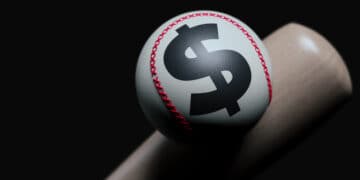- Window of Opportunity
- History Doesn’t Repeat, But it Does Rhyme
- Bad to Worse
- The Fed’s Jawbone
- Today’s Trading Plan
Friday evening, I discussed why I believe there’s a window of opportunity for a stock market rally. And I offered a few stocks from my “watch list” with good setups. I’ll dig into those stocks a little more in a minute.
But first, let me set the stage in a little detail about this window of opportunity…
Window of Opportunity
Let’s start with the observation that today’s outrageous rate of inflation didn’t just pop up out of nowhere. The prices we’re now paying for necessities were predictable and could have been prevented.
Here’s why…
Supply chains were already undergoing pressure when COVID hit. One big reason is that the labor cost advantage of manufacturing in China has been narrowing for a decade. A lot of companies had already moved or were in the process of moving operations to Vietnam, Malaysia, etc.
Other companies were bringing manufacturing back to the U.S. Supply chains were changing to meet new manufacturing and distribution processes.
But COVID stopped this evolutionary process in its tracks. Especially in China, where lockdowns were, and still are, harsh and extremely disruptive.
You may recall in the early days of COVID, some days, there’d be no cheese or toilet paper at the grocery store. The supply of a lot of things shriveled. Demand for things did not.
Lockdowns around the world caused unemployment to skyrocket. The biggest employer in the US, the restaurant industry, almost ceased functioning altogether.
The U.S. government and the Federal Reserve stepped in to backstop the economy and prevent it from falling into a depression-like spiral. The government sent checks directly to households and businesses.
The Fed cut interest rates to zero so that lending and other economic activity would continue. And it started buying nearly $100 billion in mortgage and other securities monthly to ensure interest rates stayed rock bottom.
Make no mistake: this was the right thing to do. It’s also important to understand that COVID stimulus strategy was very different from the stimulus-response to the financial crisis of 2008-2009.
History Doesn’t Repeat, But it Does Rhyme
When the Fed dramatically increased the money supply in 2008 and 2009, that money didn’t flood the economy and people’s bank accounts. It mostly just sat on the bank's balance sheets. Banks were able to keep lending as they nursed themselves back to health. Demand at the consumer level was tempered by the lending process and the slow recovery in home prices.
But the whole response to COVID was specifically to put cash in people’s pockets to offset lost wages so they could keep spending.
While the 2008-2009 response could be likened to using a poker on a dying fire to get a couple of flames curling up, the COVID response poured gasoline on that dying fire.
And just like a dying fire that doesn’t have enough wood left to support a sudden conflagration, damaged supply chains couldn’t keep up with the surge in consumer demand.
This is where the Jerome Powell-led Fed screwed up royally.
Economics 101 will tell you that anytime before you have too much money chasing too few goods, prices for those goods will rise.
And prices did indeed start to rise. Inflation busted over the 2% threshold, supposed to spur the Fed into action. This happened in February of 2021.
But the Fed didn’t reflexively react to the breach of its prime directive to keep inflation capped at 2%.
Instead, Fed Chair Powell used his head. He thought about it.
Now, they say history doesn’t repeat, but it does rhyme. The particulars of events are always different, even though they tend to end with the same outcomes.
So if you get bogged down analyzing the particulars, you might think this time will be different.
And I think that’s exactly what Powell did. He thought long and hard about the particulars of the COVID economy and came up with a word to explain why it would be different this time: transitory. Powell convinced himself that the massive supply and demand imbalance wouldn’t last, and that the Fed didn’t need to move interest rates out of the emergency territory.
Bad to Worse
It’s been my experience that good stories get better and bad stories worse. Bull markets have a way of uncovering new and completely unforeseen catalysts that keep the good times rolling.
And when bear markets turn over enough rocks, something nasty will jump out.
Of course, there was no way for Powell to see the future and how Russia’s invasion would crater grain supplies and send prices for energy and grains soaring.
But that’s why we have things like trailing stops and stop losses on our investments. It’s why we use moving averages for entry and exit signals. It’s why the Fed has a 2% threshold for inflation…
Don’t think, act.
Fed Chair Jerome Powell’s decision to use his judgment instead of relying on the Fed’s inflation rulebook is why inflation got so out of hand.
The Fed’s Jawbone
I guarantee that Jerome Powell has been praying to his higher power a lot lately.
“Please, please let CPI fall below 8%…”
The Fed knows well that the mortgage rates at 7% and junk bond yields at 9% are about to send the U.S. into a nasty recession.
In fact, many analysts and strategists are now saying that this nasty recession is a foregone conclusion because Chair Powell has already promised that interest rates are going from 3.25%, where they are now, to 4.5%-5% early next year.
And if we look at the rest of the world, yikes.
England could be a couple of weeks away from a complete economic collapse. EU inflation is running at 10%, and the region is already in a recession that will become nasty as soon as the temperatures fall.
Japan has had to intervene in the currency markets to support the yen, something it hasn’t done in nearly 25 years. Inflation in Turkey is running at 80%. Argentina is at 100%.
Things are on the verge of breaking.
There’s been a rising chorus from the IMF and the United Nations that Powell and the Fed need to back off the massive rate hikes before something does indeed break. But Powell and his governors have continued to promise that rates are going significantly higher.
I don’t know why the term “jawboning” hasn’t come up in the financial media. But it’s an important concept. Because the Fed’s power doesn’t come just from what it does, i.e., raising and lowering interest rates…
What the Fed says is every bit as important as what it does, at least in the short term. The Fed knows this, and jawboning is what it’s called when the Fed tries to move markets with its words.
Editor's Note: “Jawboning” is associated with the Biblical story of Samson in Judges 15:15. Samson slayed a thousand enemies using only the jawbone of an ass.
Jawboning is why mortgage rates are at 7% when real interest rates are at 3.25%. Banks have already priced in what the Fed says it will do. And that act of pricing in expectations absolutely can affect inflation. Jawboning is why the housing market is tanking…
Of course, Powell can’t admit to this. That’s why he’s praying for even the slightest downtick in inflation because that will give him the cover to take a break from these massive rate hikes or to stop its quantitative tightening.
The stock market knows this. Big investors know that if the Fed keeps going, things will break. And the reason that we have a window of opportunity for an upside move is because the big investors like JP Morgan and Goldman Sachs (and the rest) are betting that Powell is about to ease up on interest rates.
The Fed is about to pivot….
Today’s Trading Plan
Here’s my trading plan for the three small caps mentioned on Friday….
Jumia (Nasdaq: JMIA) was trading at its 7/26 close at $5.19 in the pre-market. There’s resistance at $5.65-$5.68. The 50-day moving average is just above $7. The 5 strike calls that expire October 28 around $0.50 look good.
Aehr Systems (AEHR: Nasdaq) crushed earnings two weeks ago, stock ramped 24% to $~17.50. Pulled back support for just under $14. Trading right at its 50-day moving average at $15.30 in the premarket. The $15 strike calls that expire this week, October 21, around $1 would be my choice.
(Here’s my full report on why you should buy Aehr)
And our good friend StoneCo (STNE: Nasdaq) closed Friday at previously discussed support at $10. Trading just over its 50-day moving average at $10.14 in the premarket. The $10.50 strike calls that expire on October 28, around $0.75, look good.
My trading strategy is to grab quick hitters with near-term expiration calls trading close to at-the-money. I like risk/reward for being 2:1, that is, double money or lose 50%.
Take care, and I’ll follow up on all these stocks as the market moves along.

Brit Ryle
The Profit Sector












